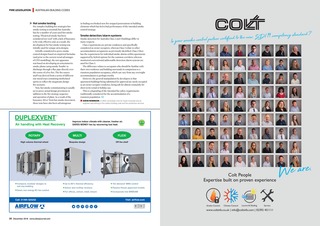




FIRE LEGISLATION | AUSTRALIAN BUILDING CODES Hot smoke testing For complex building fire strategies hot smoke testing is essential; but Australia has for a number of years used hot smoke testing. Theatrical smoke has been considered too cool with a lack of buoyancy to be truly effective and, as a result, the development for hot smoke testing was initially used for unique atria designs. Initially considered to prove smoke control designs based on empirical formulae (and prior to the current trend advantages of CFD modelling), the test apparatus was based on developing an axisymmetric smoke plume using smoke bombs to discharge through a flue pipe directly over the centre of a live fire. The fire source itself was derived from a series of different size metal trays containing methylated spirits to reflect the megawatts design fire scenario. Now, hot smoke commissioning is usually set to prove actual design provisions in addition to the fire strategy sequence and operation of plant. As a result of the buoyancy drive from hot smoke movement, these tests have also been advantageous in finding overlooked non-fire stopped penetrations in building elements which has led to bad performance of the intended smoke control strategy. Smoke detection/alarm systems Smoke detection for Australia Class 2 and 3 buildings differ in many respects. Class 2 apartments are private residences and specifically considered as owner occupiers, whereas Class 3 relate to other accommodation occupancies as previously identified. Class 2 then has the requirement for individual smoke alarms within apartments supported by hybrid options for the common corridors; whereas monitored conventional/addressable detection/alarm systems are used for Class 3. The difference relates to occupants who should be familiar with their own residence and building surrounds in comparison to a transient population occupancy, which can vary from any overnight accommodation to perhaps weekly. However, the general manipulation by developers is that apartment buildings being submitted for approval are rarely occupied as an owner occupier residence, being sub-let almost constantly for short term rental or holiday use. This is a degrading of the intended fire safety requirements traditionally considered for the accommodation of a transient population. CJ DAVID ROBINSON is CIBSE committee chair for South Australia and an engineer specialising in fire-safety building code and fire-protection services Improve indoor climate with cleaner, fresher air. SAVES MONEY too by recovering lost heat. Air handling with Heat Recovery ROTARY MULTI FLEXI High volume thermal wheel Bespoke design Off the shelf Compact, modular designs to suit any building Quiet, low energy EC fan control Call: 01494 525252 Up to 95% thermal efficiency Indoor For and rooftop versions offices, school, retail, leisure On-demand Passive BMS control House approved models Incorporate into BREEAM Visit: airflow.com Certificate No. EMS 569454 Certificate No. FM 00152 BS EN 1SO 14001 : 2004 BS EN 1SO 9001 : 2008 30 December 2018 www.cibsejournal.com CIBSE Dec18 pp28-30 Smoke Control v2.indd 30 23/11/2018 17:42